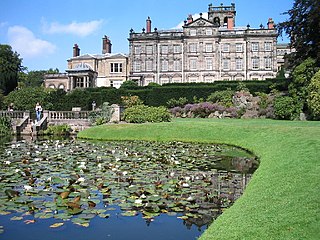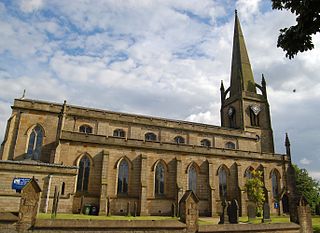Buildings and structures
| Name and location | Photograph | Date | Notes | Grade |
|---|---|---|---|---|
| Damhouse 53°30′11″N2°27′22″W / 53.503°N 2.456°W |  | 1650 | Damhouse or Astley Hall was the manor house for Astley though it is inside the Tyldesley boundary. It was used as the administration block for Astley Hospital. Since 1991 Morts Astley Heritage Trust has renovated it for office use and tea room. [4] The house is built of rendered brick with stone details and a slate roof. The three-storey frontage has five unequal bays with stone mullioned windows and crosswing gables. The central three-storey porch bay has a studded oak door with Doric columns, pediment and a fanlight. The frontage is largely as built but the plaque over the door is a replacement. The east wing dating from the early 19th century is of rendered brick and has a chapel on the first floor. [5] Restoration in 1999-2000 discovered the attic contained a "short" long gallery that had subsequently been subdivided. [6] | II* |
| Morleys Hall 53°29′21″N2°28′09″W / 53.4892°N 2.4693°W |  | 16th century | Morleys Hall, now a private residence, is a moated hall converted to two houses on the edge of Astley Moss. The hall which was largely rebuilt in the 19th century on the site of a medieval timber-framed house, incorporates elements from the 16th and 17th centuries. [7] The moat a scheduled monument. [8] | II* |
| Morleys Hall Barn 53°29′21″N2°28′09″W / 53.4892°N 2.4693°W | early 19th century | Morleys Hall Barn comprises an early 19th-century threshing barn, byre and overloft and a lower range to south. It is built in red brick in English garden wall bond and has a slated roof. It has a recessed entry bay above which are stacked decorative ventilation panels. [9] The moat a scheduled monument. [8] | II | |
| Astley Vicarage 53°30′10″N2°27′14″W / 53.5029°N 2.4540°W |  | 1704 | Astley Vicarage is built in English garden wall bond brick. It has three storeys and its twin-gabled front has five bays and a central door. The house has had few alterations since it was built and is a combination of early Classical and vernacular architecture. [10] Pevsner considers it a "very attractive and interesting house" possibly dating to 1704. [6] | II* |
| Gatepiers at Astley Vicarage 53°30′10″N2°27′14″W / 53.5029°N 2.4540°W | 18th century | The 18th-century square stone gate piers at Astley Vicarage have moulded bases and caps. The timber gate is a replacement. [11] | II | |
| Astley Green Mining Museum Winding House 53°29′44″N2°26′48″W / 53.4956°N 2.4467°W |  | 1912 | The former engine house housing Astley Green Colliery's twin tandem compound steam engine is now part of Astley Green Colliery Museum. It is built in brick, seven bays long and three bays wide under a slate roof. The bays have round-arched windows with iron glazing bars. [12] The site is protected as a Scheduled Monument. [13] | II |
| Astley Green Museum Winding Tower 53°29′43″N2°26′48″W / 53.4952°N 2.4467°W |  | 1912 | Astley Green Colliery Museum has the only surviving headgear on the Lancashire Coalfield. It is made from wrought iron lattice girders with rivetted plates at the joints. It has two large and one small wheels mounted at the top. It is nearly 30 metres (98 ft) high and was built by Head Wrightson of Stockton-on-Tees in 1912 for Astley Green Colliery. [14] The site is protected as a Scheduled Monument. [13] | II |
| Manor House Farmhouse 53°29′55″N2°26′52″W / 53.4986°N 2.4477°W | 1730 | Manor House Farmhouse is a three-storey house built in brick with slate roof. Originally built with three bays a fourth was added later. The doorway has Ionic half-columns and plain entablature. The house has sash windows to the front and casement windows to the rear. [15] | II | |
| Sales House 53°29′01″N2°27′56″W / 53.4836°N 2.4656°W | 17th century | Sales House is a mid-to-late 17th-century farmhouse built in English garden wall bond brick with a stone slate and slate roof. The two-storey house has a T-shaped plan and four bays one of which is a gabled crosswing. It has its original boarded door with strap hinges. [16] | II | |
| Peel Hall 53°29′36″N2°27′21″W / 53.4934°N 2.4559°W | 16th century | Peel Hall was built in the 16th century but rebuilt in the 18th and early 19th centuries. It is built on a moated site of English garden wall bond brick with slate roof on a projecting stone plinth from an earlier building on the site once owned by Cockersand Abbey. [17] | II | |










